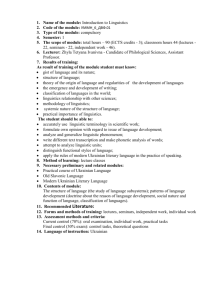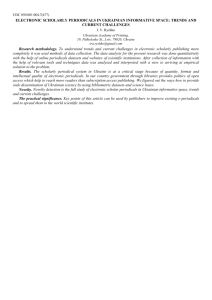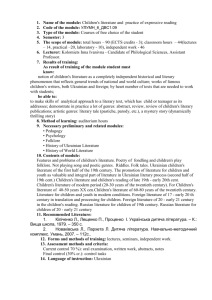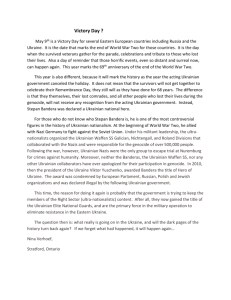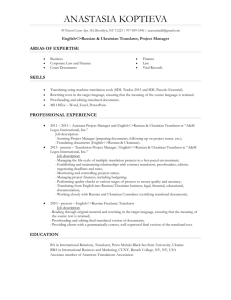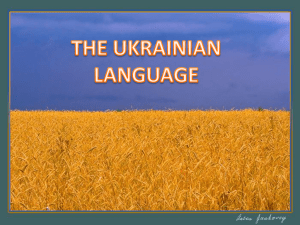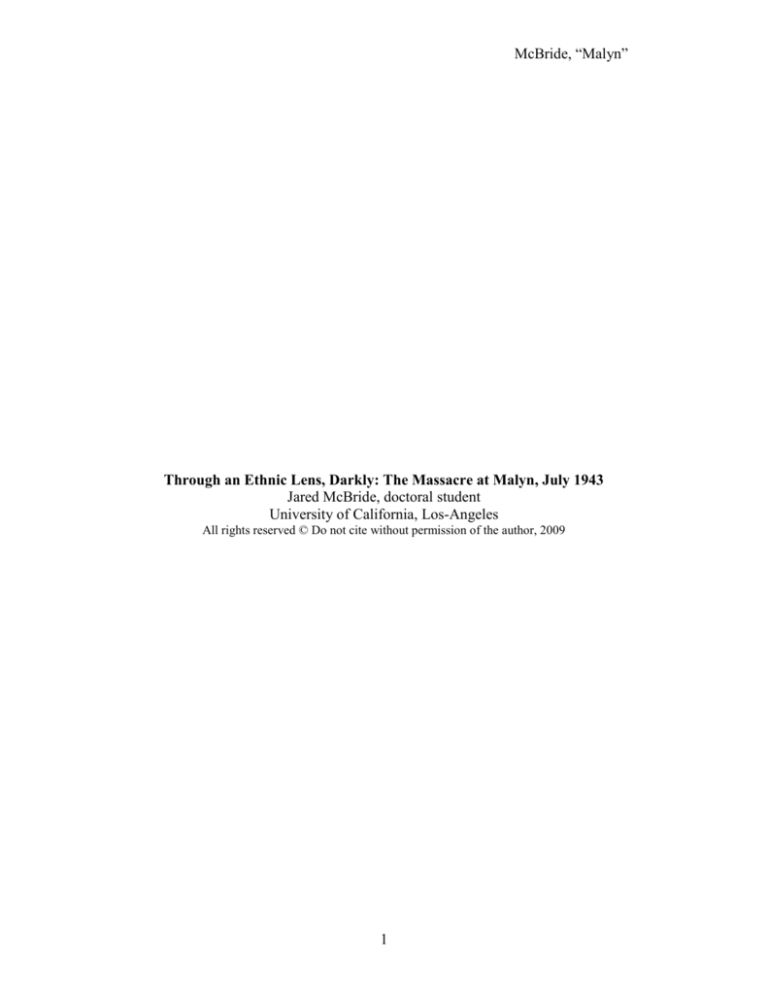
McBride, “Malyn”
Through an Ethnic Lens, Darkly: The Massacre at Malyn, July 1943
Jared McBride, doctoral student
University of California, Los-Angeles
All rights reserved © Do not cite without permission of the author, 2009
1
McBride, “Malyn”
On the morning of 13 July 1943 a German “anti-partisan” detachment cordoned
off Malyn, a small village consisting of a Czech and smaller Ukrainian colony, located in
the Ostrozhets raion of Rivne oblast’ in Volhynia. Following a protocol played out in
villages all over Western Ukraine that spring and summer, soldiers rounded up the
population from their homes and jobs, claiming that there were would be a registration in
the town square. The soldiers then drove the entire Czech population to the Ukrainian
section of Malyn, where they and the Ukrainian residents were divided by gender. The
women and children were taken to the Orthodox Church, while another group was taken
to barns and sheds. The men were taken to Malyn’s school and town hall. Before they
reached their final destination, some soldiers undertook another curious filtration
processes and separated the population by nationality. Malyn’s citizens were then locked
inside these structures while the soldiers laid down straw, poured gasoline, and lit the
buildings ablaze. As those locked inside panicked and were engulfed by the flames, the
soldiers “threw grenades in the windows” and “opened fire on [the burning buildings]
with machine guns and tommy-guns.” The cries could be heard as far away as
Zamczysko, a Polish village located a kilometer from Malyn.
By the end of the day, 603 people --194 men, 204 women, and 205 children--had
been burned alive or shot to death. Among the victims were Czechs, Poles, Ukrainians,
and Russians. Only ten of the 120 homes of the village remained intact; hundreds of
barns and storehouses had been burned down. By the evening of 13 July 1943, the village
of Malyn had ceased to exist. Malyn had become one of some 450 Ukrainian villages
destroyed during the war. Their crime? The German forces undertook this reprisal in
response the support given by the Czech villagers to a Soviet partisan division. According
to partisan commissar S. V. Rudnev, the “cultured” Czech villagers were very “warm” to
the Soviet partisans and provided them with various foodstuffs.
By the time of the reprisal against Malyn the dynamics of the occupation in
Volhynia had undergone a major shift. At the beginning of summer 1943, the Volhynia
region became the central location of partisan warfare--German estimates range up to
70,000 Soviet partisans. The Germans responded to this problem the only way they knew
how -- by pure force, wiping villages out all over the region. Also by the spring of 1943,
2
McBride, “Malyn”
members of the regenerated Ukrainian Insurgent Army (Ukrainska povstanska armiia
[UPA]) had received their orders to “kill all Poles, Czechs, and Jews on the spot,”
marking an initiation of their ethnic cleansing campaign of Volhynia in anticipation of a
Soviet reoccupation. UPA and Soviet partisans also clashed regularly. With the desertion
of many Ukrainians from their posts in the German police, many Poles under threat of
UPA violence joined the German ranks for protection and even began to attack Ukrainian
villages in kind. In effect, what broke out in Volhynia was a “civil war” augmented by a
brutal foreign occupation that just turned even crueler..
This civil war had a major effect on the ranks of the already strained German
occupation forces. The ratio of Germans to local collaborators in many departments and
police organizations ran from 1:5 in 1941 to 1:20 or more by 1943. Figures from the
Reichskommissariat Ukraine show the SS employed some 15,000 Germans and 238,000
native police at the end of 1942, reflecting a ratio of nearly 1:16, a proportion that rose to
1:25 or even 1:50 in some regions by 1944. This should tell us that it was impossible for
the division that destroyed Malyn to be purely “ethnic” German. The German division
that destroyed Malyn was comprised of both a Polish police division from Olyka and a
number of Ukrainian schutzmanner that remained in German service. In fact, this reprisal
was an example of a multi-ethnic division under German command destroying a multiethnic village -- an incident that was not uncommon during this time.
Creative Remembering and Creative Forgetting: Memory of the Second World War
in Eastern Europe
“This was a barbaric act…I wonder why it was not published.”
Working in the state archives of the Russian Federation in 2001, I can across a
dozen testimonies located in the Extraordinary State Commission (ChGK) files that told
the story of what happened in Malyn. Oddly I had never heard of this village or its fate.
Unlike other “martyred villages” from the Second World War, such as Lidice or OradourSur-Glune, Malyn has only appeared periodically in English-language works, often as
just another passing example of Nazi brutality in the East. In an initial attempt to simply
discern whether this was in fact an anti-partisan reprisal and not an act of ethnic cleansing
3
McBride, “Malyn”
by Ukrainian nationalists, I searched for more information. In my initial inquiry, I
encountered a dizzying array of explanations as to what happened on 13 July 1943 in
memoirs and secondary literature. Not only were the explanations for the reprisal varied,
but the facts about the reprisal themselves were far from lucid. The date and time of the
reprisal was not clear, not to mention the ethnicity of the perpetrators seemed to morph
from account to account, as well the victims’ ethnicity. In some accounts Poles were
responsible, elsewhere it was Ukrainians, others Vlasovites -- even Uzbeks were blamed.
Thus, the initial results of my search produced more obfuscation than illumination.
To probe the historical record even further, I turned towards scholarly accounts
from Eastern European historians. To my dismay, this effort caused even more problems.
The discord between Soviet, Ukrainian, Polish, Czech, and English-language accounts of
what occurred was so great that there did not seem to be a possible way to bridge them.
Armed with archival references, oral histories, and a litany of explanations, each historian
made very specific “truth claims” about Malyn, but none meshed. As I began to check
and cross-reference their footnotes and claims in half a dozen languages and archives in
four different countries, a much more distinctive pattern emerged.
In this paper, I will dissect four distinct discourses or narratives on the massacre
of Malyn -- Soviet, Ukrainian, Polish, and Czech, and I will sort out the complex process
of “creative forgetting” and “creative remembering,” to adapt the phrase of one Polish
historian, which has so often plagued the memory of the second World War in Eastern
Europe. My task is twofold -- I will interrogate the source base used in each of these
narratives, while also explaining and charting the trajectory of the narratives themselves.
It is my contention that if we peer through the ethnic prism at Malyn, we will learn more
about how the war is remembered in Eastern Europe, rather than the massacre itself.
Soviet Malyn: “The Eternal Flame of Malyn” and Druzhba Narodov
Before we can look through the ethnic prism at Malyn we must examine Malyn
through the Soviet prism. The massacre at Malyn was not particularly difficult to
integrate into the Soviet narrative about the Great Patriotic War in Ukraine. Malyn was
utilized in two manners, first in a denigration of the “bourgeois Ukrainian nationalists”
4
McBride, “Malyn”
who fought for independence from the Soviet Union, and second as a unifying symbol of
druzhba narodov between Ukraine, Czechoslovakia, and Russia. These efforts were by
no means mutually exclusive, nor do they follow a clear and logical trajectory, as we
shall see.
Before Malyn was used as a weapon against Ukrainian nationalists, there was an
initial phase after the war, which marked a singular focus on the Germans. As the Red
Army reoccupied Eastern Europe in 1944, the Extraordinary State Commission collected
countless testimonies from villagers all over Ukraine, including Malyn. What is most
interesting about these testimonies about Malyn is that there is absolutely no discussion
of the ethnic component of the massacre. The perpetrators are strictly referred to as the
ubiquitous “German-fascists invaders” and in many places the testimonies share similar
structure. This initial tendency to keep the lid on the Pandora’s box of ethnic antagonism
is also reflected in Josef Martinovský’s book on Malyn, published in 1945 by a Soviet
publishing house, and another report on the massacre compiled by General Ludvik
Svoboda of the 1st Czechoslovak Army Corps. It is seemingly by chance that a set of
unadulterated testimonies found their way into a small pamphlet entitled Nezapomeneme
Pomstime!, which was published in Czechoslovakia in 1945. In this pamphlet one can
find testimony from many of the same individuals who spoke with ChGK, but these
testimonies provide a much more explicit discussion of the massacre.
By 1959, Malyn had already morphed from a crime of “German fascism” to that
of Ukrainian bourgeois nationalism. In the spring of 1959, twelve pits were discovered in
Malyn that reportedly contained over 200 victims of UPA terror. While Malyn, like many
villages in Volhynia, experienced some minor attacks by UPA and other bands in the
summer and spring 1943, there is absolutely no evidence to support the claim that some
200 citizens of Malyn were murdered by the UPA. Though Malyn was repopulated to
some extent after the war, one should remember there were no citizens in Malyn to be
killed after July 1943. These small details, of course, proved no obstacle for local Soviet
Ukrainian leaders eager to exploit the discovery in the name of Ukrainian bourgeois
nationalism and druzhba narodov. Authorities dug up the bodies (likely the bodies from
the anti-partisan reprisal) and held a grandiose funeral, which an alleged 25,000 people
attended from all over the oblast’. At the funeral ceremonies the local party secretary of
5
McBride, “Malyn”
Ostrozhets raion, K. P. Novakovets’ declared, “We will never forget, nor forgive the
Ukrainian bourgeois nationalists and the horrors [they committed].” He added, “We will
strengthen the unbreakable brotherhood of Soviet Ukraine and we will strengthen the
unbreakable brotherhood of Russian, Ukrainian and other nations of the USSR.”
Throughout the 1970s and 1980s, Malyn remained a symbol of joint suffering
between the Czech, Ukrainian, and Russian people. In 1979 a Czech delegation visited
Malyn. This delegation presented the people of Malyn with gifts from the citizens of
Lidice and Nový Malín, Malyn’s postwar namesake in Czechoslovakia. In an article
describing the meeting entitled, “The Eternal Flame of Malyn,” L. Matviichuk noted,
“Near the graves of our brothers -- the victims of fascism and Ukrainian bourgeois
nationalism, a meeting took place between Soviet and Czechoslovakian nations.” Here
we can clearly see how Malyn served as a unifying symbol of druzhba narodov for these
“brother” nations who both suffered at the hands of Ukrainian nationalists and the
German fascists.
The Soviet narrative about Malyn even found its way into English-language
propaganda pamphlets intended for Anglo-American audiences. In a polemical pamphlet,
Judas’s Breed, author Yuri Melnichuk recalled how he himself “stood beside opened
mass graves or wells filled with the corpses of his countrymen who were victims of the
terror of the OUN…in the village of Malin [sic] alone, these butchers burned some 900
Ukrainians and Czechs, threw 223 peasants into a well to die a slow death, and buried
alive another nine innocent people.” Improvisations were not left to the pamphleteers
alone. In a document collection ironically entitled History Teaches a Lesson, a letter from
Bishop Platon of Rivne, stored in the Kyiv archives, was reprinted to demonstrate the
crimes of the Ukrainian nationalists at Malyn. The problem is that the editors managed to
edit the sections of Platon’s letter where he blames the massacre on the “godless” Poles
and Uzbeks, not the Ukrainians.
Ukrainian Malyn: “The Tragedy of Malyn is the Tragedy of Ukraine”
After the dissolution of the Soviet empire, a proliferation of new narratives of the
war has flourished in Eastern Europe. One of the most hotly contested places for memory
6
McBride, “Malyn”
became Ukraine -- a country that suffered immensely during the war, yet also saw the
highest level of collaboration of any Eastern European countries. A deluge of new works
on the war has populated the academic and popular cultural landscape in Ukraine over the
last two decades, though sadly, the breadth and often times honesty of the debate has not
been commensurate with the quantity of new material. A prevailing tendency in both
scholarly and popular discourse has been to create a sanitized history of the war that
presents the incipient Ukrainian nation as a victim of both Fascist Germany and the
Soviet Union. Malyn has become a useful tool in this process -- it has been used to
admonish the Soviets, Poles, and Germans for their actions against Ukrainians, and
second, to co-opt the victimhood of the Czechs into a larger struggle for Ukrainian
statehood.
For Ukrainian historians, journalists, and commentators, the prevailing version of
what happened at Malyn was that a Polish police division under German command
helped commit the reprisal. Examples such as Malyn are often used to show that Polish
attacks on Ukrainian villages were commiserate with the ethnic cleansing campaign
enacted by the OUN/UPA in 1943 and 1944 against their neighbors. There have been two
types of sources used to justify this version of the Malyn massacre. The first set of
sources has been the memoirs of former UPA soldiers, namely Danylo Shumuk and
Volodymyr Danyliuk. While the memoirs do provide a valuable look at the lives of UPA
soldiers, the veracity of their accounts regarding events at Malyn can easily be questioned
due to a number of quizzical assertions, which bear no relevance to the actual events.
The second main source has been the Litopys collection of the UPA. Though the
Litopys collection contains two UPA reports that mention Malyn, only one of which
implicates the Poles, Ukrainians have ignored the first report that implicates the Germans
and solely used the second. The reliability of the Litopys collection in general is tenuous
at best given its selective choice of documents and propensity to skim over Ukrainian
crimes. A number of Ukrainian historians have used these sources exclusively to
demonstrate that this anti-partisan reprisal was an example of Polish revenge and
brutality. As a rule, those who use these sources have failed to check or question the
reliability of these sources, let alone consult or cross-reference them with other possible
sources.
7
McBride, “Malyn”
The most grievous abuses have come from the prominent Ukrainian historian,
Volodymyr Serhiichuk. In the document collection, Poliaky na Volyni, Serhiichuk cites
Vasyl’ Kvasha, an alleged resident of a nearby village, as a source to prove Polish
culpability. According to Serhiichuk Kvasha “recalled” that Poles took part in the
massacre, not to mention they were singing Polish nationalist songs on the way home
from Malyn. Serhiichuk also uses an UPA “situational report” to implicate Poles in not
only the Malyn reprisal, but also reprisals against five other villages -- a report that does
not mention Poles at all. The same approach is repeated in Trahediia Volyni where
Serhiichuk uses another UPA situational report to implicate Poles, though this report also
does not mention the Poles, but instead only comments on “German” involvement.
Representations of Malyn have not been limited to “academic” circles alone in
Ukraine. Pushing beyond the sole implication of Poles in the massacre, Ukrainian
journalists labored to blame Soviet partisans. Vasyl’ Kvasha and Serhii Kachynsk’kyi
both claim that Soviet partisans “terrorized” the people of Malyn, stole their products,
and promised to protect them from the Germans, only to hide in the forest and watch
while Germans destroyed Malyn. They cite nothing to prove these claims, other than
circumstantial evidence that Medvedev and Kovpak partisans allegedly attacked other
villages in the region. Other improvisations include various falsehoods about the Polish
collaborators, an accusation that Kovpak’s men killed fifteen people in Malyn, and that a
UPA unit tried to defend Malyn during the reprisal – all fallacious claims backed by no
evidence.
The most radical revision to the Malyn narrative came when Stepan Semeniuk
went as far as to claim that “Czechs [of Malyn] actively supported the Ukrainian
independence movement” and that this had something to do with the reprisal. There is no
evidence in the historical record to back this assertion for the case of Malyn, let alone
other Volhynian villages. If anything, Czechs often supported their Polish neighbors in
the ethnic strife, though they were well-known for their neutrality by all. One might also
question why there are various reported attacks on Malyn residents by UPA units if the
Czechs were such sympathizers to the nationalist cause. Placing Malyn’s Czechs within
the struggle of Ukrainian nationalist struggle has allowed Semeniuk to co-opt their
victimhood and re-inscribe it into the nationalist Ukrainian narrative; hence it is no
8
McBride, “Malyn”
surprise that the “tragedy of Malyn” thus becomes the “tragedy of Ukraine” in this
Ukrainian narrative.
Polish Malyn: Omnipresent Ukrainian Police
Polish historians have not shied away from Malyn either. The Polish narrative for
Malyn can be understood through a similar ethnic dynamic that drove Ukrainian
historians and journalists. Polish historiography of the war in the Western Ukraine cannot
be understood without the backdrop of the Ukrainian nationalist ethnic cleansing
campaign that claimed tens of thousands of Polish lives during the last two years of the
war -- it is this event that casts a long shadow over the Polish treatment of Malyn.
The largest scholarly undertaking to deal with the Ukrainian ethnic cleansing
campaign was completed by the father and daughter tandem of Wladyslaw and Ewa
Siemaszko. Their ten-year project documented thousands of individual ethnic cleansing
episodes in Volhynia. It is in this project that we find the most extensive scholarly effort
to deal with Malyn. They provided a key micro-history of Malyn before and during the
war, elucidating all of the Ukrainian nationalist attacks on Malyn, not compiled anywhere
else. Moreover, they utilized numerous interviews with Volhynian residents from the
period of war, as well as archival and Czech sources. They reached the conclusion that
Germans, with the aid of Ukrainian police, committed the reprisal. Despite their strong
research, the Siemaszkos have eagerly dismissed Polish involvement, claiming they could
not have taken part in the reprisal. The Siemaszkos handled the Ukrainian question
regarding Malyn in a well-researched manner and drew informative conclusions, but their
inability to contemplate confirmed Polish police involvement exhibits their own
disconnect when it comes to evaluating Malyn on an ethnic level.
The Siemazskos are not alone though. Another Polish historian, Adam
Peretiatkovich, also insinuates that Ukrainians were responsible for the reprisal. In a
similar fashion to Ukrainian historians blaming the impetus for the reprisal on Soviet
partisans, Peretiakovich blames the reprisal on a supposed “denunciation” by Ukrainian
nationalists. He then claims a tenuous link to Ukrainian participation in the reprisal,
noting that many Ukrainians served in the Vlasovite divisions and it was namely the
9
McBride, “Malyn”
German Wehrmacht, SS division, and Vlasovites who destroyed Malyn. Furthermore, he
claims that a number of the Ukrainian villagers left the village before the reprisal since
they were “warned in advance” about the foreboding massacre. Peretiatkovich also
provides no citations to support any of these assertions.
The judicious Polish historian, Gregory Motyka, is the only historian from either
camp to admit participation of his own ethnic group. In an article in Karta about Polish
participation with German forces, Motyka accused Polish police of involvement in the
reprisal. To support this admission Motyka uses less than reliable sources, such as
Shankovsky’s memoir and Kosyk’s general history of the war -- both Ukrainian deniers
of OUN/UPA crimes in Volhynia. Even stranger, Motyka then cites the dubious Platon
letter, in which Platon, based on hearsay, accuses the “godless” Poles and Uzbeks of the
crime. While Motyka’s admission should be applauded since it is technically correct, his
work should have been grounded in better research. The substitution of one skewed
source base for another is not sound scholarly practice, especially in such contentious
matters.
New and Old Czech Malyns
At last, we turn to the Czech community to see how they have created their own
narrative about Malyn. Many Czechs migrated east to Volhynia during the 1860s and
1870s due to economic reasons. The Czechs, who brought with them their agricultural
expertise, assimilated well into their new multi-ethnic communities, mainly as framers.
Generations of Czech farmers lived peacefully in the multi-ethnic Western Ukraine
throughout the various regime changes until the start of the Second World War. During
the war the Czech minority not only had to survive the brutal German occupation, but
also the “nationally inflamed environment” that engulfed Volhynia, as one Czech
historian described it. In this dangerous landscape, many Czechs joined the underground
Blanik organization, which supported Czech government abroad and created its own selfdefense units. Many Volhynian Czechs also joined the 1st Czechoslovak Army Corps in
1944 that helped drive the Germans back to Berlin. The Volhynian Czechs were hardly
rewarded for their efforts and bravery. By May 1947 some 33,000 Czechs were forcefully
10
McBride, “Malyn”
transferred out of Volhynia to Czechoslovakia by Soviet authorities. In a minor
concession the town of Frankstat was renamed “New” Malyn (Nový Malín) in honor of
Malyn on 13 July 1947. Over one hundred Volhynian Czechs, including former Malyn
residents, were resettled there.
The most prominent figure in the shaping of the Czech narrative has been Josef
Martinovský, a Volhynian Czech who lost his entire family in Malyn while he was
fighting in a Soviet division. Martinovský’s memoir, Kronika Ceskeho Malina, remains
the only monograph devoted solely to the story of Malyn. Regarding the ethnic issue,
Martinovský’s work is somewhat cryptic. In both editions of his chronicle, there is only
one sentence devoted to this issue: "the apostates of both nations, Ukraine and Poland,
participated in the butchering of the Czechs of Malyn.” There is little doubt that these
publications went through heavy censorship by Soviet authorities and this likely
contributed to his muted discussion of the issue. In an unpublished account of Malyn,
Martinovský notes that the “wicked Schutzman police” took part. Only in his testimony
from the post-war Czechoslovakian publication does Martinovský clearly accuse both
Poles and Ukrainians of involvement in the massacre.
Despite Martinovský’s cryptic allusions and extensive recollections about Malyn,
contemporary Czech historians have left the contentious issue virtually untouched. It is
not that there is a lack of interest in Malyn -- in the post-communist era, Malyn has
garnered some interest in the Czech Republic, especially among the progeny of
Volhynian Czechs. In a number of publications, Czech historians and journalists have
collected testimonies from neighbors and survivors that focus on the fate of Volhynia’s
Czechs, including Malyn. Their focus and anger has been directed at the “fascists” or
“Germans” and in many cases against the Soviet Union and Communist Party of
Czechoslovakia (KSC) for the expulsion of Czechs from Volhynia and their subsequent
treatment within CSR.
Like the other narratives, this one is also far from monolithic. A small group of
historians have begun writing about the ethnic complexities in Volhynia during the war
and how they affected the Czechs. Such historians as Jaroslav Vaculik and Jiri Hofman
have documented attacks on Czechs by Ukrainian nationalists and discussed issues like
collaboration among the local population. Even in popular Czech literature, one can read,
11
McBride, “Malyn”
“Day and night [the UPA] attacked Czech villages and killed innocent people” and that
the Ukrainian nationalists were interested in preserving the “ethnic purity of Ukraine.”
Despite these new developments, no one has dealt with Malyn outside of the
“victims of fascism” troupe. To date, I have been able to find only one Czech mentioning
of the ethnic issue. In recent years, Jarsolav Mec, a leader in the Volhynian Czech
Association, noted, “I have never read such information [of Poles participating in the
pacification of Malyn]. From the beginning, when our people moved from Volhynia we
were in contact with each other and talked about those difficult times. Nobody, at any
point, had any doubts that this atrocity was undertaken by the Germans with the help of
the Ukrainian police.” Mec’s account is unique in that no other testimonies in the Czech
literature make such a claim about Malyn.
This seemingly gossamer Czech narrative should not surprise us though. The fact
that Malyn has served solely as a “symbol of suffering for the Volyn Czechs” since the
end of the Second World War and not as a part of a larger discussion of ethnic issues in
Western Ukraine actually makes a lot of sense. As historian Omar Bartov has noted, “The
victim troupe is the central feature of our time” and this troupe is a useful one for Czechs
today. The victim troupe allows Malyn to serve as a rallying point for the Volhynian
émigré community in the Czech Republic and helps integrate them into a larger Czech
narrative concerning their victim status at the hands of the two goliaths, Fascist Germany
and Soviet Russia. In short, it has a practical function, whereas forays into the minefield
of ethnic politics in Ukraine and Eastern Europe would provide no practical benefit.
Memory as a the Anti-Museum: Temporary Conclusions
“Memory is a sort of anti-museum: it is not localizable”
What if we were to build a museum to the memory of Malyn? What would we put
in this museum? How many rooms would be needed? In what language would the
exhibits be constructed? In what country should the museum be located? In Ukraine? In
contemporary Malyn? In Nový Malín? Moreover, how might we build this museum?
Would we build it from the memories collected by Czech, Ukrainian, Polish, or Russian
historians? How would we privilege one testimony or history over another?
12
McBride, “Malyn”
The problem I have displayed in this paper is by no means a new one in the
Eastern Europe field or history profession in general. Some historians of Eastern Europe
have already begun to tackle these issues. For example, Piotr Wróbel, a Polish historian,
has coined the term “double memory” to explain the divergence in Jewish and Polish
memories of the same events that transpired during the war. Jeffrey Burds has even
expanded this model to triple or quadruple memory (or “multiplicities of memory”) when
dealing with interethnic violence during this time period.
This micro-history of Malyn has presented a twofold predicament. Not only are
the memories themselves, whether they be plucked from the archives, memoirs, or
secondary literature, problematic in that they are filtered through a prism of ethnicity,
ideology, and politics, but the way in which they are then used to construct histories of
the war by historians, journalists, and other interested parties are also guided by a set of
precepts (be it nationalism, victimhood, ideology). A disinterested party (in the sense of
not taking sides) entering this maelstrom with the hopes of creating a viable history of the
events that transpired will realize the magnitude of the obstacles to their work and even
sanity. It is no wonder Burds has remarked, “A historian’s motives will be impugned no
matter how diligent the research[!]” when dealing with such topics.
This does not mean we should shy away from the task all. A positivistic approach
is always necessary -- at no time should one concede the search to post-modernist
meanderings and fatalism (the type that would claim that there are many “truths” for
Malyn). The first order of business is simply to be aware of the problems that plague such
historical inquiry, which is why papers such as this are being written. This awareness will
help guide historians away from many of the pitfalls outlined in this paper. Second, one
needs to learn how to unpeel the layers of obfuscation, both in and between the primary
sources and their subsequent use by scholars. In undertaking this process, Dominick
LaCapra’s assertion that “History and memory should neither be opposed in binary
fashion nor conflated” is certainly germane.
Take for example, a comparison between the Polish and Ukrainian historians’ use
of local memory to support their cases. Each side has based much of their “truth claims”
on oral testimony from Volhynian residents present during the war. While Serhiichuk and
company have found a number of Ukrainians to support their claim of Polish
13
McBride, “Malyn”
involvement, the Siemaszkos have found Poles to prove their case. Utilizing testimony
from Polish Volhynians, Roman Kucharski, Antoni Cybulski, Leopold Dryda and Jozef
Szczurowski, the Siemaszkos were able to deduce that “German soldiers and Ukrainian
police” committed the reprisal. How is it that Ukrainian historians have managed to find
Ukrainian villagers who all solely accuse Polish police, while Polish historians have
managed to find Polish villagers who all solely accuse Ukrainian Police? The appearance
of this predicament alone should tell us that there is a major problem with both versions
of the story and that neither should be relied upon solely to make “truth claims.”
We can find similar problems with the morphology of the victims’ identity from
Malyn. In earlier work by Wladyslaw Siemaszko (completed with Jozef Turowski) the
Ukrainian victims of Malyn even managed to disappear. The Polish historians claim,
“The Germans burned to death 603 Polish and Czech inhabitants of the village of Malin,”
despite the fact that four times as many Ukrainians were victims. In similar cases,
Ukrainian historians have left out all Polish victims and Czech historians have often
excluded the Polish and Ukrainian victims. If we had to choose, which set of victims
would we agree upon if we had no other data available?
Thus one must learn to unpack the sources of memory from their historiographical
trajectories and deal with each of them in their own right. Again LaCapra provides
applicable insight, “At its best historiography contributes to the public sphere a critically
tested, accurate memory that groups in society may possibly internalize as the
remembered past.” This case study has shown that when filtered through the lens of
ethnic conflict, nationalism, and even victimology, the results of are often replications of
these precepts and not the event itself. The irony is that since the dissolution of the Soviet
Union, new histories have often ridiculed the Soviet narrative for its own liberal use of
truth and facts, but within this newly granted space the “nationalist” and supposedly
objective analyses are often no better. If “memory as part of the experience of a group is
bound up with the way that a group relates to its past as it bears on its present and future”
we can see clearly through the Malyn example how these groups are relating to their past
and future.
In order to build our museum, we must recognize that memory is in fact not
locate-able or localizable. It does not reside in one narrative or another, nor does it reside
14
McBride, “Malyn”
in one testimony or archival document. It morphs over time. Historians and public figures
use it inaccurately at times and others disfigure and distort it. Our museum should not
reside in any country. The language of the exhibits should be universal and accessible to
all, as should access to the museum. The centerpiece should be the victims, but rooms
should be devoted to the perpetrators as well. The victims should be presented for who
they were, what happened to them, and why. Likewise, the reasons the perpetrators were
involved should be explicated. Other rooms should be dedicated to the time period and
environment in which this tragedy occurred to give context. Any pieces of memory and
history that help to tell this story and the truth about what happened to them should be
collected, preserved, and displayed.
15
McBride, “Malyn”
16

